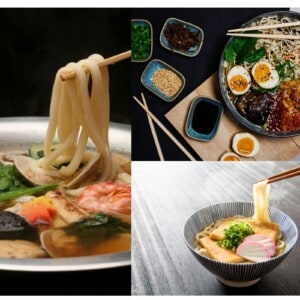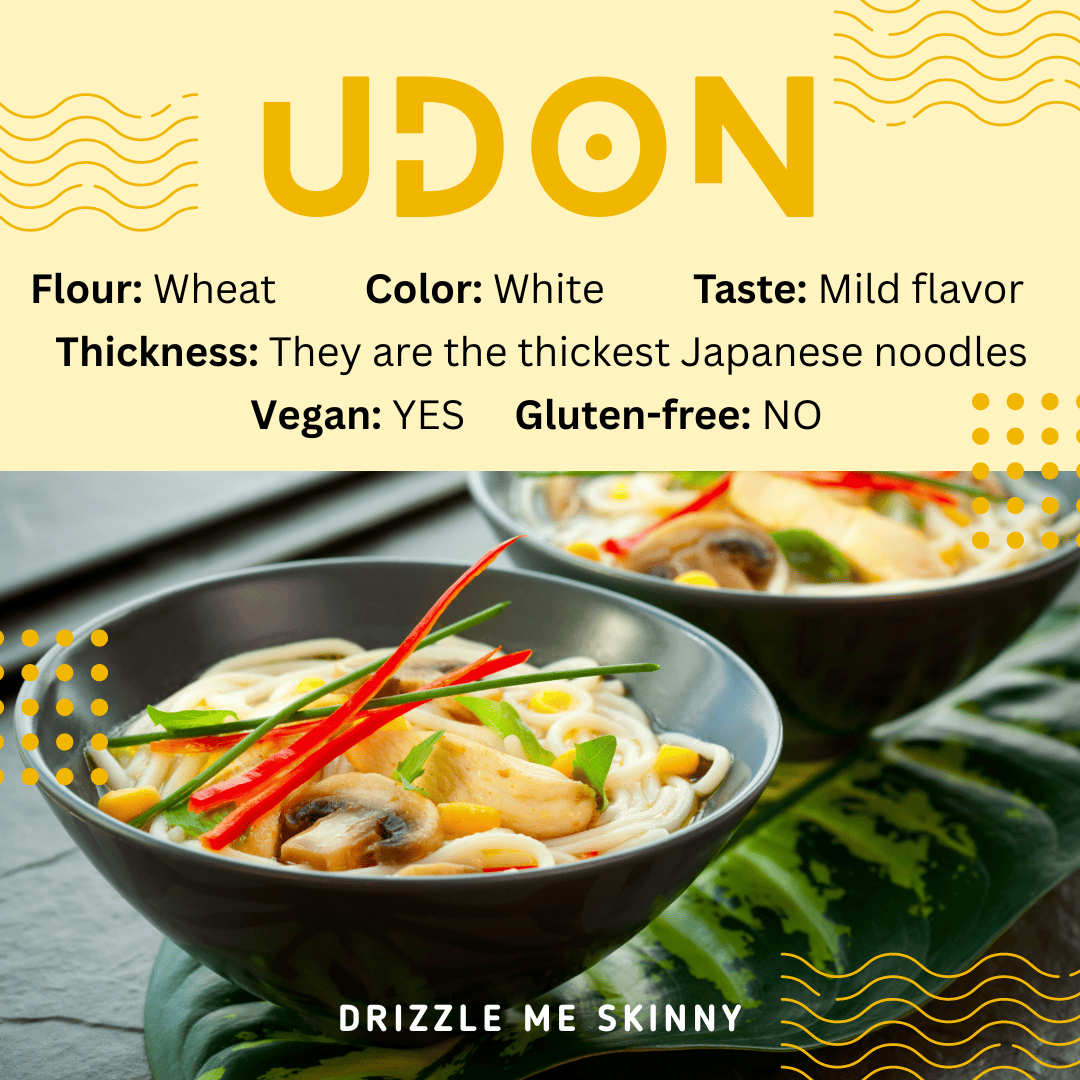If you’ve ever eaten Japanese food, you know that this cuisine is so much more than sushi and sashimi. In fact, noodles are arguably the most popular food across this island nation. You can find them in vending machines and fancy restaurants alike.
Not only are noodles incredibly versatile but there are so many types of noodles to choose from. In this guide, we take a deep dive into udon vs ramen noodles, defining what they are, how they’re served, and what makes these wheat noodles different.
[ez-toc]
What is ramen?
Ramen noodles are springy, yellow noodles made from wheat flour, water, salt, and kansui (alkaline mineral water). Ramen noodles are typically thin and spaghetti-shaped, though their size and shape can vary greatly depending on where they’re made.
Kansui is the ingredient that distinguishes ramen noodles from the many other types of Japanese noodles. This alkaline mineral water is comprised of sodium carbonate, potassium carbonate, and sometimes phosphoric acid and originated from Inner Mongolia. It gives ramen its texture and signature yellow color.
Types of ramen dishes
Traditionally, ramen noodles are served in broth in a soup of the same name (ramen). Ramen soup dishes consist of broth, seasonings, noodles, and various toppings.
Common toppings for ramen include bok choy, simmered pork (chasu), hardboiled egg slices, dried seaweed, kamaboko (fish cake), mushrooms, corn, butter, bamboo shoots/menma, and green onions or scallions.
There are many types of ramen broth, but here are some of the most popular traditional broths:
-
- Shoyu ramen: Soy sauce, water, vegetables, and meat bones are boiled into a light brown sauce.
- Tonkotsu ramen or Hakata ramen: A milky, opaque, and flavorful broth made by boiling pork bones over a long period of time. Beef bone can also be used.
- Shio ramen: Made from chicken or fish bones and vegetables, this broth is pale to golden yellow in color.
- Miso ramen: This can be a clear miso broth or a tonkotsu broth into which miso (fermented soy paste) has been added.
- Karē (Curry) Ramen: Curry paste is added to shio or shoyu broth for a clear soup or to tonkotsu that tastes like the perfect combo of Indian and Japanese.
Best ramen recipes
Our favorite ramen recipe comes from The Kitchn and walks you through making a perfect broth, noodles, seasoning, and toppings. If you’re cooking from scratch, this is the way to go! For easy yet mouthwatering ramen made from instant packets, head over to the New York Times Cooking.
What is udon?
Udon is a thick noodle made from wheat flour, water, and salt. Udon noodles are white in color and have a chewy texture. These noodles have a very subtle flavor. Because they absorb a lot of liquid, they take on the flavor of broths and sauces well.
Types of udon dishes
Udon noodles are as versatile as they are popular in Japan. They can be served hot or cold, depending on the season. They are commonly added to soups and stir-fries or chilled and served in a salad or accompanied by dipping sauces.
Here are some popular dishes using fresh udon noodles:
-
- Tanuki udon: A soup dish with udon noodles in a dashi broth and garnished tenkasu tempura flakes.
- Kitsune udon: Made with fragrant dashi broth and udon noodles, this soup is typically topped with deep-fried tofu (aburaage).
- Kake udon: A simple dish of udon noodles coated in mirin, soy sauce, and dashi stock and sprinkled with sliced green onion. Usually served warm.
- Zaru udon: Cold udon noodles with a mentsuyu sauce consisting of sake, mirin, soy sauce, kombu, kelp, and katsuobushi (dried bonito flakes).
- Curry udon: Japan meets India in this thick, curry-flavored soup with udon noodles.
- Tempura udon: Udon noodles in dashi broth with crispy pieces of tempura shrimp and veggies.
- Sanuki udon: Noodles in a broth made from dried sardines, kelp, soy sauce, and other seasonings, such as garlic.
One great udon soup recipe
Ready to slurp up a bowl of udon? This chicken and scallions udon noodle soup recipe from Food Network has our mouths watering too! Ready in just 30 minutes, this nourishing and flavorful dish is sure to please the whole family.
Summary: What is the difference between ramen and udon?
These iconic Japanese noodles are both wildly popular in Japan and beyond. While they are both wheat-based and often used in soups, they have some notable differences.
- Thickness: Udon noodles are the thickest Japanese noodles. Ramen noodles are typically thinner, like spaghetti, although their size and shape vary greatly.
- Color: Ramen noodles have a distinct yellow color due to kansui. Udon noodles are white.
- Texture: Ramen noodles are springy while udon noodles are much softer.
- Dishes: Ramen noodles are almost exclusively served in soups (with some modern exceptions). Udon noodles can be served hot or cold in soups, stir-fries, salads, and more.
Related Recipes
If we’ve got you craving some Japanese food, be sure to check out our 25 Exciting Japanese Eggplant dishes!
And to continue your deep dive into the world of Japanese noodles, this Udon vs Soba Noodle article or this Nigiri vs Sashimi article should quench your thirst for culinary knowledge!
Frequently Asked Questions (FAQs)
Which is healthier ramen or udon?
Udon is considered the healthier of the two because it is typically served with simpler toppings. Ramen has more sodium due to kansui and is often served with butter and other rich toppings.
Are udon noodles gluten-free?
Udon noodles are made from wheat flour and thus are not gluten-free. For a gluten-free option, try soba noodles, which are made of buckwheat flour.
Is udon or ramen more popular in Japan?
While both are incredibly popular staples of Japanese cuisine, ramen is the most widely eaten noodle dish in Japan.
Ramen vs Udon: What's the Difference?

Instructions
- Pick your favorite recipe
- Click the link to view the recipe
- Follow the linked instructions
- Enjoy!



